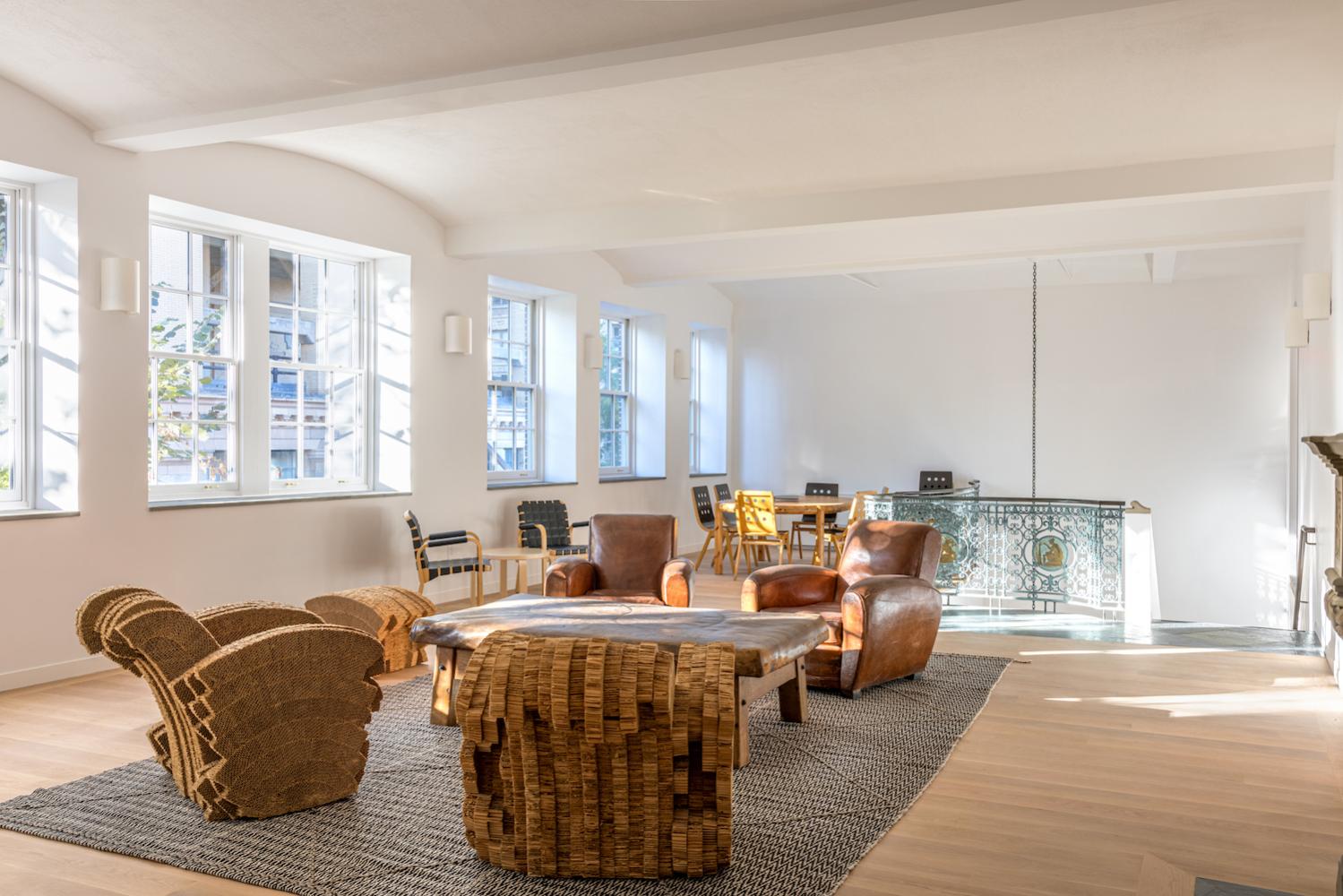Whitney Museum opens Renovated Roy Lichtenstein Studio

The Whitney Museum of American Art has completed a full renovation of iconic artist Roy Lichtenstein’s former home and studio at 741/745 Washington Street in Greenwich Village.
The project—made possible thanks to an extraordinary act of generosity by Dorothy Lichtenstein on behalf of the Estate of Roy Lichtenstein—transformed the historic space into the first permanent home for the Whitney’s celebrated Independent Study Program (ISP), which for 55 years has nurtured artists, critics, and scholars, providing participants with the instruction, space, and support needed to pursue their artistic endeavors.
Architects Johnston Marklee led the thoughtful design of the project, making respectful modifications to update the over-100-year-old building to accommodate modern artist studios, a seminar room, study rooms, outdoor spaces, a third-floor artist-in-residence addition, and amenities such as lounges and dining areas while also preserving the legacy and historic integrity of the structure.
The now 11,000-square-foot building at 741/745 Washington Street was constructed in 1912 as a metalworking shop. Lichtenstein—whose Centennial is being celebrated today—bought the building in 1987 after he “fell in love with it,” according to Dorothy Lichtenstein, and used it as his New York residence and studio from 1988 to 1997. In the years since, the Roy Lichtenstein Foundation has utilized the building for various activities, including the preparation of the archives and creation of the catalogue raisonné. In 2022, the Lichtenstein family donated the building to the Whitney, which has had a close relationship with the late artist since first displaying his work in 1965.
The renovation—approved by the New York City Landmarks Preservation Commission in 2022—retained several historic elements from Roy Lichtenstein’s time, such as a chandelier in the central stairway, ornamental metal details, and the artist’s unique rail system for hanging his oversized paintings to dry; they remain on the first floor of the building as an inspiring reminder of the work done in that space previously.
“This project is so important to me and to the Whitney, as it truly sits at the heart of our mission to support American art and artists in innovative ways,” said Adam D. Weinberg, the Alice Pratt Brown Director of the Whitney Museum. “The original Whitney was the studio of our founder Gertrude Vanderbilt Whitney, where she held salons and conversations and gatherings of artists. The ISP is a continuation of Gertrude’s tradition, and to have its first permanent home be in the same space where an iconic American artist questioned hierarchies and worked to evaluate, understand, and critique pop culture, is just perfect. I cannot thank Dorothy Lichtenstein enough for her generosity, which will have a positive impact for generations to come.”
“This is the most wonderful way to celebrate Roy’s legacy,” said Dorothy Lichtenstein, president of the Roy Lichtenstein Foundation. “The ISP is such an extraordinary organization, and I am so proud to support it in any way possible. I am so pleased with the sensitive way the architects designed this space, which is so important to me, and was so important to Roy. It was his favorite studio, and I know he would be very happy.”
“To help create a permanent home for the Whitney Independent Study Program in the former home and studio of Roy and Dorothy Lichtenstein has been an honor,” said Sharon Johnston, FAIA, and Mark Lee, Founders and Partners at Johnston Marklee. “We worked on both preserving and transmitting the qualities of the former 1912 metal shop and Lichtenstein’s studio into an accessible home for the ISP filled with daylight. Each floor of the building has been transformed to serve different needs for the new community of artists and thinkers.”
Lichtenstein’s studio on the ground floor is now a collection of 15 individual studios; his former office is adapted to become ISP’s fabled Seminar Room. On the second floor, the former living room accommodates communal spaces for meeting and research. With a generous visual porosity to the street and within the block, the communal rooftop garden also on the second floor includes Lichtenstein’s Garden Brushstroke (1996/2009) that was donated by the Roy Lichtenstein Foundation.
The new third-floor addition—an artist’s studio—is set back from the historic façade and is framed by three large windows, conveying the scale and atmosphere of historic artists’ studios in Greenwich Village.
“On the exterior, the building is both recognizable and discreet, an architecture that fits into the neighborhood and only speaks when engaged,” Johnston and Lee continued. “On the interior, the spaces are both communal and intimate, creating an environment for both contemplation and discourse for this new chapter of the ISP.”
The space will primarily be used for the Whitney’s ISP, a core component of the Whitney’s role as a champion of American art and artists since 1968. When the ISP is out of session, the Whitney intends to use the space for educational programs for teens and other New Yorkers.
ISP alumni include artists Jennifer Allora, Tony Cokes, Danielle Dean, Mark Dion, Andrea Fraser, LaToya Ruby Frazier, Felix Gonzalez-Torres, Renée Green, Jenny Holzer, Emily Jacir, Glenn Ligon, Rirkrit Tiravanija, and Julian Schnabel; critics and art historians Huey Copeland, Miwon Kwon, Pamela M. Lee, and Roberta Smith; and curators Carlos Basualdo, Naomi Beckwith, and Sheena Wagstaff, among many others.
The program has had many locations, but never a permanent home.
“To have a permanent space where artists, curators and critics can gather and create, discuss and research together, in Manhattan, in such close proximity to the Whitney and other cultural institutions, is an incredible, transformative moment for the ISP,” said Gregg Bordowitz, director of the Independent Study Program. “The surrounding neighborhood, steeped in rich art history, serves as an extraordinary resource for ISP participants and, by extension, the arts communities in New York City. As an artist and ISP alum, I am humbled and honored to inherit this beautiful, historic space, and look forward to moving the ISP into a new chapter.”
Main Image :Foto: Max Touhey/Whitney Museum/dpa
